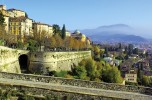Premiato il sito seriale e transnazionale che coinvolge anche le mura di Bergamo
A un anno e mezzo dalla presentazione ufficiale dell’impegnativo dossier di candidatura all’Unesco, di cui Bergamo è stata orgogliosamente città capofila, lo scorso luglio “Le opere di difesa veneziane tra XVI e XVII secolo. Stato da Terra - Stato da Mar occidentale” sono entrate a far parte del Patrimonio dell’Umanità: si tratta del 53esimo sito in Italia, nazione che si conferma detentrice del record mondiale di siti iscritti alla lista del World Heritage Centre. Il sito è seriale e include le fortificazioni presenti a Bergamo, Peschiera del Garda e Palmanova in Italia, Zara e Sebenico in Croazia e Cattaro in Montenegro.
L’idea della candidatura nasce a Bergamo nel 2007: Giovanni Carullo, storico del Comune, lancia la proposta di valorizzare le fortificazioni veneziane dello Stato da Terra e Francesco Macario, all’epoca assessore della giunta Bruni, crede nel progetto e lo sostiene fin dall’inizio.
Nel 2012 viene istituita l’Associazione Terra di San Marco, presieduta da Luciana Frosio Roncalli che con Roberto Amaddeo, consigliere comunale delegato al progetto Unesco dal sindaco Giorgio Gori, ha curato la candidatura gestendo i complessi rapporti diplomatici con i governi degli altri stati coinvolti nel progetto.
La transnazionalità è un grande valore aggiunto e conferma l’orientamento che sta caratterizzando le scelte del Comitato del Patrimonio Mondiale: è ormai raro che vengano premiate singole città o centri storici; la tendenza è quella di valorizzare beni dislocati in più Paesi, per intrecciare relazioni non soltanto geografiche ma anche politiche.
Il sito è ufficialmente riconosciuto come unico e le tre nazioni hanno firmato un accordo sulla sua gestione futura, promessa di cooperazione internazionale per gli anni a venire.
La nuova concezione dell’architettura militare
La storia delle opere di difesa veneziane inizia nel XV secolo: allora il livello territoriale, economico e commerciale raggiunto dalla Serenissima era tale da imporre un piano unitario volto al rafforzamento della difesa delle frontiere dalle minacce nemiche.
Il progetto era ambizioso: data l’estensione del territorio la protezione dei limiti della Repubblica avrebbe richiesto tempi di costruzione dilatati e risorse considerevoli.
Era inoltre necessario ripensare l’architettura militare realizzando un sistema innovativo che difendesse dall’impeto distruttivo delle artiglierie diffusesi con l’introduzione in guerra della polvere da sparo.
Le fragili e slanciate strutture medievali, divenute inadeguate alle nuove tecniche belliche, vennero sostituite da possenti fortificazioni protette da bastioni e dotate di stanze di deposito, passaggi interni, cannoniere; la struttura urbana all’interno delle mura fu rimodellata per costituire autentici distretti militari: vennero aperte ampie piazze dove raccogliere le truppe, realizzati magazzini per la polvere da sparo, costruite fontane e cisterne per garantire l’approvvigionamento di acqua anche in caso di assedio.
L’operazione ebbe una dimensione colossale.
La qualità e la durevolezza dei risultati sono testimoniate dal buon livello di conservazione mantenuto dalle diverse opere del sito; questo soddisfa i requisiti di integrità e autenticità imposti dall’Unesco. Inoltre le fortificazioni sono tuttora inserite nei contesti urbani e fanno da teatro alla vita delle comunità cittadine.
Un altro aspetto emblematico dell’eccezionalità del sito è la notevole varietà di queste opere: pur formando un complesso unitario i cui metodi di costruzione, progettazione e distribuzione degli spazi rivelano l’imprinting veneziano, rappresentano la versatilità delle soluzioni che la Serenissima elaborò per adattarsi alle diverse caratteristiche geomorfologiche dei territori. Idealmente si sviluppano, oltre che nello spazio, anche nel tempo: ognuna di esse documenta una delle fasi di ricerca che, nel corso del XVI e XVII secolo, portò gli ingegneri veneziani a definire soluzioni architettoniche sempre più perfezionate.
Uno spazio ideale
Le opere sono distribuite su un’area di oltre mille chilometri e testimoniano la storica suddivisione che la Repubblica di Venezia assegnò ai propri domini: lo Stato di Terra, delimitato a occidente da Bergamo e rappresentato nel sito anche da Peschiera, sul lago di Garda, e Palmanova, città-fortezza utopica a forma di stella nella pianura friulana, e lo Stato da Mar occidentale, che include le opere difensive della costa della Dalmazia, Zara, Sebenico e Cattaro, località affacciate sul mare Adriatico e per questo strategiche per i commerci tra Venezia e il Levante.
Il sistema di fortificazioni codificato dalla Repubblica di Venezia fu detto “alla moderna” e divenne presto un riferimento internazionale nel campo delle arti civili e militari. Tale opera tradusse sul territorio i principi rinascimentali di integrità e continuità rappresentati dalla Serenissima che, anche grazie all’elaborazione di questa innovativa opera di difesa, segnò indelebilmente la cultura moderna.
Livia Salvi
UNESCO: The Venetian works of defence, a World Heritage site
The serial, transnational site, which also includes Bergamo’s walls has been honoured
Last July, a year and a half after the official presentation of the formidable candidacy dossier to UNESCO, of which Bergamo was proudly the torchbearer, “The Venetian Works of Defence between the 16th and 17th Centuries.
Stato da Terra – Western Stato da Mar” became part of UNESCO’s list of World Heritage sites. It is the 53rd such site in Italy, a country that holds the world record for places registered on the list of the World Heritage Centre. The site is serial and includes the fortifications in Bergamo, Peschiera del Garda and Palmanova in Italy, Zadar and Šibenik in Croatia, and Kotor in Montenegro.
The idea of the candidacy was developed in Bergamo in 2007: Giovanni Carullo, municipal authority historian, launched the proposal to promote the Venetian fortifications of the Stato da Terra (Land State), and Francesco Macario, at the time councillor of the Bruni executive council, believed in the project and supported it from the very beginning.
In 2012, the “Associazione Terra di San Marco” (Land of St. Mark Association) was set up and presided over by Luciana Frosio Roncalli who, with Roberto Amaddeo, municipal councillor appointed to the UNESCO project by the mayor Giorgio Gori, supervised the candidacy, managing the complex diplomatic relations with the governments of other countries involved in the project.
The project’s transnationality is a great added value and confirms the direction that has recently been characterising the choices of the World Heritage Committee: it is now unusual for individual cities or old town centres to be honoured; the tendency is to promote heritage located in several countries, in order to build both geographic and political relationships.
The site is officially recognised as unique and the three nations signed an agreement on its future management, a promise of international cooperation for the years to come.
The new concept of military architecture
The history of the Venetian defence works began in the 15th century: then the territorial, economic and commercial level achieved by the Serenissima was such that a unified plan was ordered, which was aimed at strengthening border defences from enemy threats.
The project was ambitious: given the extension of the territory, the system defending the Republic’s borders took a significant amount of time and considerable resources to build. It was also necessary to rethink military architecture, creating an innovative system that defended against the destructive violence of the artillery that spread after the introduction of gunpowder in wars.
The fragile and slender medieval structures became unsuitable for these new war techniques and were replaced by mighty fortifications protected by bastions and equipped with store rooms, internal passages and cannon placements.
The urban structure inside the walls was remodelled to form real military districts: wider squares were opened to hold troops, stores were built for gunpowder and fountains and cisterns were constructed to guarantee a water source in the case of siege.
The operation was of colossal dimensions. The quality and durability of the results are demonstrated by the excellent state of preservation of the different works included in the site. This satisfies the requirements of integrity and authenticity imposed by UNESCO.
In addition, the fortifications are still found in urban environments and act as a backdrop for city life. Another prime example of the excellent features of this site is that there is considerable variation in the different works.
Although they make up a single complex whose methods of construction, design and distribution of spaces is clearly Venetian, they demonstrate the versatility of the solutions that the Serenissima devised to adapt the constructions to the diverse geomorphological features of the land. Ideally these constructions not only have a physical dimension but also one of time: each documents one of the stages of experimentation that, during the 16th and 17th centuries, led Venetian engineers to come up with increasingly advanced architectural solutions.
An ideal space
The site of the works extends over more than a thousand kilometres and demonstrates, historically, the way the Republic of Venice divided up its domains: the Land State, bound to the west by Bergamo and including Peschiera, on Lake Garda, and Palmanova, a star-shaped utopian fortress-city on the Friuli plain, and the western Sea State (Stato da Mar), which includes defensive works on the coast of Dalmatia, Zadar, Šibenik and Kotor, towns on the Adriatic Sea and for this reason strategic for trade between Venice and the East.
The system of fortifications brought together by the Republic of Venice was known as “alla moderna” (modern style) and soon became an international reference in the field of civil and military arts. This work reflects the Renaissance principles of integrity and continuity represented by the Serenissima which, thanks in part to the construction of this innovative work of defence, left an indelible mark on modern culture.














